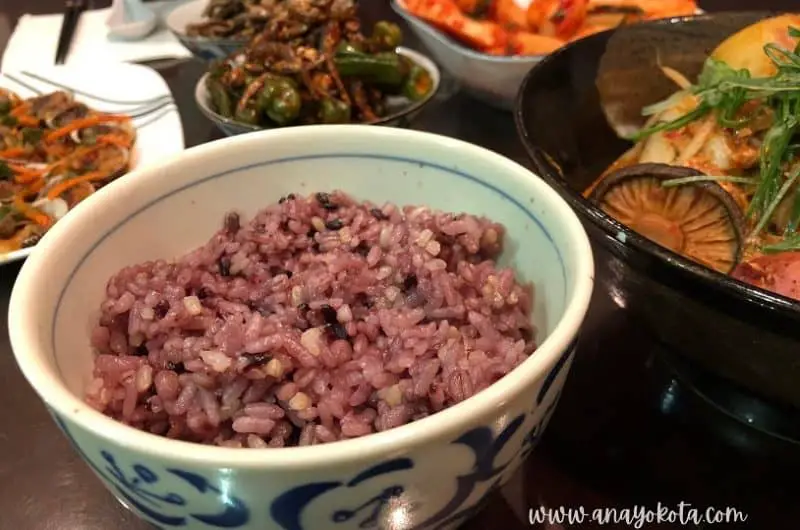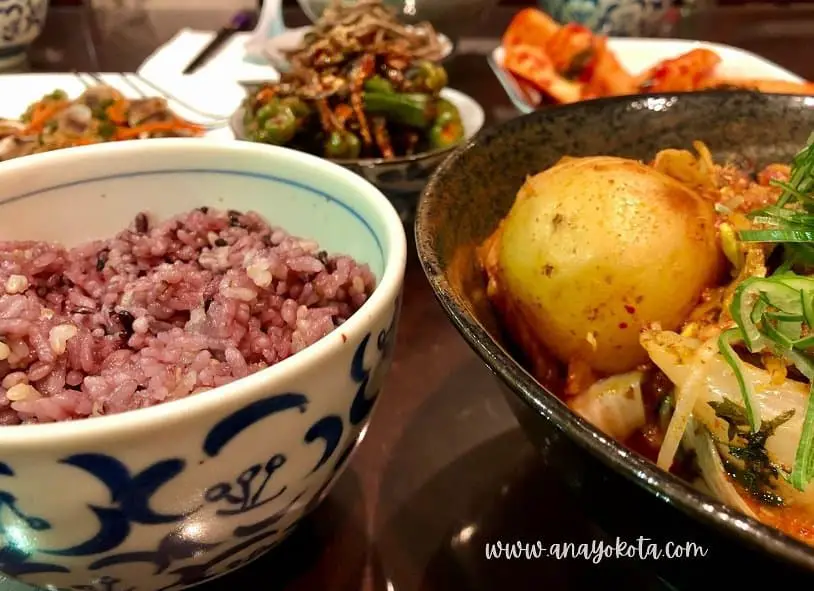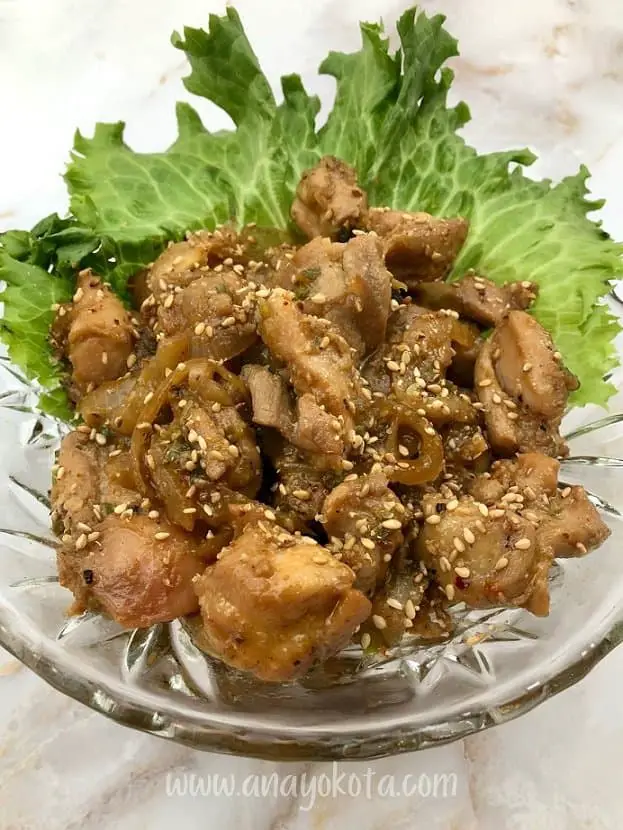This post may contain affiliate links. Please read my disclosure policy for more info.
Korean purple rice is a delicious and healthy concoction of multigrain rice that is easy to make at home. Unlike plain white rice, Korean purple rice has a deep nutty flavor with excellent texture in every bite.
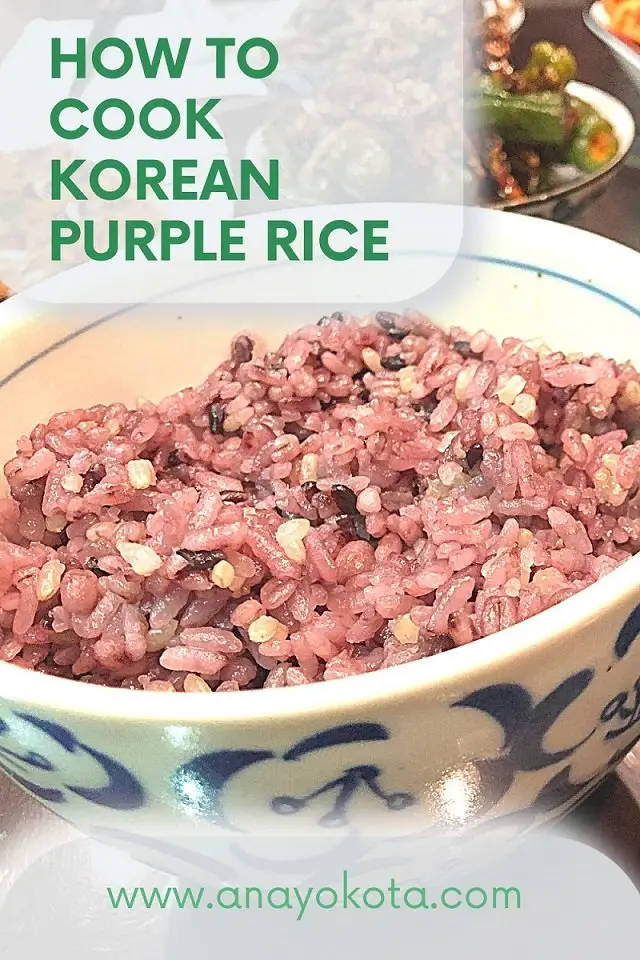
Korean purple rice has been a huge staple not only in my household, but also in many Korean households worldwide. It is very common to see Korean food offer a variation of this delicious multigrain rice not only because it’s tasty but also very pretty, too. Though there are many amazing ways you can combine rice to make Korean purple rice, the one thing you always need is black rice, which I’ll explain in a minute.
Many of my friends have been asking me how I make my Korean purple rice and it makes me smile to know that it is incredibly simple and easy to make especially if you have a rice cooker. But I also realize that there are a few key tips that I’ve discovered to make your rice game that much more amazing.
Aside from it’s upgraded flavor from plain white rice, I learned that the health benefits of Korean purple rice is so convincing, you’ll probably never want to go back to plain rice again. Allow me to bring you on a rice journey to help you understand a little more about this beautiful cultural phenomenon.
WHAT IS KOREAN PURPLE RICE
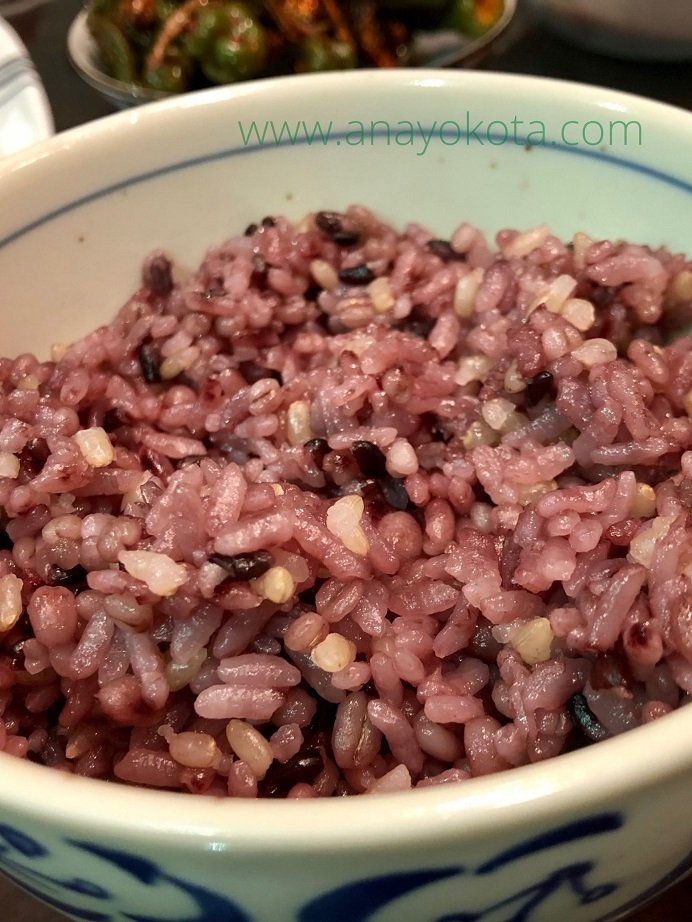
Korean purple rice is typically made with a combination of grains cooked in one pot. The most important factor that makes this rice purple is the black sweet rice (or black long grain rice). Depending on different styles and preferences, Korean purple rice can include many different types of rice. The most common combination is short (or medium) grain white rice, brown (or regular) sweet rice, and black rice.
To break the actual word down:
In Korean, purple rice is 흑미밥 (heuk mi bap).
- 흑 (heuk) means black
- 미 (mi) means rice
- 밥 (bap) means cooked rice
- Put it all together, (heukmibap) and you have purple rice.
It isn’t called “black rice” because it is widely understood that black rice (heukmi) is not the only ingredient when making purple rice. As mentioned earlier, there are many different variations when using black rice.
If you are choosing to use other whole grains such as barley or brown rice, another very popular name for this combination is 잡곡밥 (japgokbap), which means multigrain rice or mixed grain rice.
HISTORY OF PURPLE RICE

Purple Korean rice (like all other rice) originated from Asia – specifically, Japan (SOURCE).
It is also believed that the black rice (the main ingredient to making Korean black rice), has a couple Chinese nicknames such as forbidden rice or emperor’s rice because it was more difficult to grow and therefore reserved for royalty.
Legends aside, the fact remains that the origin of black rice is Asia. The spread of this novel rice is due to a long series of plant evolution (Oryza sativa) with the accumulation of proanthocyanidins (a chemical compound that gives plants their red, blue or purple color) resulting in this dark red hue (SOURCE).
Beware of the fake stuff. There are several counterfeits to black rice. The easiest way to authenticate black rice is conducting a clear vinegar test. To learn more about authenticating rice, click HERE.
HEALTH BENEFITS OF PURPLE RICE

Is Korean Purple Rice Healthy?
Absolutely. However, keep in mind that the amount of health benefits totally depends on how much black rice you incorporate into the purple rice mixture. The more black rice you add, the more health benefits you will reap from the black rice. Obviously, some black rice is better than none.
According to the US Department of Agriculture, black rice alone is packed with more nutritional protein, iron and fiber than that of plain white rice (SOURCE 1, SOURCE 2).
As mentioned earlier, black rice contains a plant compound called proanthocyanidins or anthocyanins. In short, anthocyanins are a derivative of proanthocyanidins, which allows plants their bluish purple color (SOURCE). Anthocyanins are packed with antioxidants (SOURCE). A very popular example is blueberries.
Since black rice is not the only grain used in this recipe you will reap the health benefits from other multigrains you choose to add. Since this post isn’t about the science behind various types of rice grains, I will provide a high level overview of the health benefits of this particular recipe. (However, if you would like a deeper dive on rice, let me know! I’m a data nerd when it comes to this stuff)
Fiber. The barley rice alone is packed with soluble fiber (the stuff that helps you poop). Most whole grains (when the outer shell of a grain is still intact) will have higher fiber content than that of refined (stripped butt naked) grain. In this recipe, you have 3 out of 4 whole grains. Not too shabby.
Protein. Even grains have protein. Black rice has a whopping 4 grams per quarter cup (SOURCE). Many vegetarians will consume whole grains due to its great source of protein compared to white rice.
Iron. Iron is a beautiful superhero mineral that is essential to help transport oxygen in the human body and multigrain rice has loads of iron (SOURCE).
Antioxidants. Remember the thing that makes your black rice purple? Anthocyanins are stored in the outer layer of the grain and that is where you will find the antioxidant properties for black rice.
HOW TO COOK PURPLE RICE

The ratio between black rice and the other types of rice depends on how purple you would like to make the rice. The more black rice you add, the more purple your rice will cook. Not to mention, the health benefits of black rice is incredible.
I personally enjoy a darker purple rice with the following rice ratios:
- 1 part black rice
- 2 parts sweet brown rice
- 2 parts barley rice
- 8 parts white short grain rice
For example, I will use a quarter cup of black rice to about two cups of white rice.
As for the very important water ratio: Depending on what method you use (rice pressure cooker, Instant Pot, or stove top) the amount of water will vary:
- Rice pressure cooker and instant pot will generally use a 1:1 water to rice ratio because the steam will do most of the work.
- As for stove top, so long as you soak the rice properly, you will need about a 1.25:1 water to rice ratio because you will need more liquid to supplement the evaporated steam.
PRO-TIPS
There are three major pro-tips that I live by when cooking purple rice (or pretty much most rice combinations):
- Soak. Soak the rice anywhere between 1-3 hours. If you are just using white rice, you can get away with soaking it for 30 minutes, but since my recipe requires other multigrains, you want to ensure a healthy soak time for optimal results. Soaking the rice allows the gRains to absorb the water and help accelerate the cook time. Since rice has absorbed water, it also allows for the full flavor of rice to permeate throughout the rice. Therefore, the longer you are able to soak the rice the more flavorful the rice will cook.
- Sake. Yes, sake! Soju also works very well. According to The Japan Times, while rice is being cooked, the sake creates a compound called Inosinic acid (IMP), as well as glutamate, the main compound of umami taste (SOURCE). In other words, sake (or soju) enhances the flavor of rice making the entire experience even more delicious. In my experience, I feel that the rice not only smells sweeter but also has sweeter flavor notes.
- Rice Pressure Cooker. I understand that not everyone will own a rice pressure cooker. But let me tell you, it makes it that much better. Not only is using a rice pressure as easy as (literally) pressing a button, you can ensure that the rice will be evenly and perfectly cooked. Less stirring, less wondering, less working = easy peasy lemon squeezy.
FAQ
Purple rice vs white rice
The biggest difference between purple rice and white rice comes down to color, ingredients, and flavor. Purple rice typically will have 3-4 different types of grains while white rice is just white rice.
Where to buy purple rice
I purchased my purple rice ingredients at my local H Mart (Asian grocery store). You can easily purchase the following on Amazon:
Is Korean purple rice gluten free?
Yes. Korean purple rice is entirely gluten free.
Why Korean eat purple rice?
Due to its tastier and healthier content along with its visual aesthetics, many Koreans like eating purple rice.
Is purple rice good for diabetics?
Epidemiological studies suggest that foods that have anthocyanins promote healthy properties, which may reduce anti-inflammatory issues that are known to diabetics (SOURCE).
Why is it so important to cook rice with the lid on the pot?
Rice needs steam to cook properly and evenly. When the lid is not on the pot, you risk the rice on the bottom to cook faster, potentially burning it, while you may get undercooked rice on the top leaving it crunchy. A lid can ensure even cooking throughout the rice.
Healthy Korean Purple Rice Recipe
Cuisine: KoreanDifficulty: Easy6
bowls1
hour5
minutes50
minutesHealthy and easy Korean purple rice made with nutritious multigrain rice
Ingredients
2 cups – short grain white rice
½ cup – sweet brown rice
½ cup – barely rice
¼ cup – black rice
1 tbsp – cooking sake or soju
3 ¾ cups – water for rice pressure cooker method
4 cups – water for Instant Pot method
4 ¼ cups – water for stove top method
Directions
How To Cook Black Rice In Rice Cooker
- Place all the rice in a rice washing bowl. The beauty of having a rice washing bowl is that it is designed with a solid button with a side drain, which could be used to wash and drain in a more efficient and effective way. If you don’t have one, you can use a fine strainer or a medium sized bowl.
- Be gentle as you rinse and drain the mixed rice. Repeat 3 times.
- Place the drained rice in a pressure cooker.
- Pour water over the rice and let it soak for at least 1 hour.
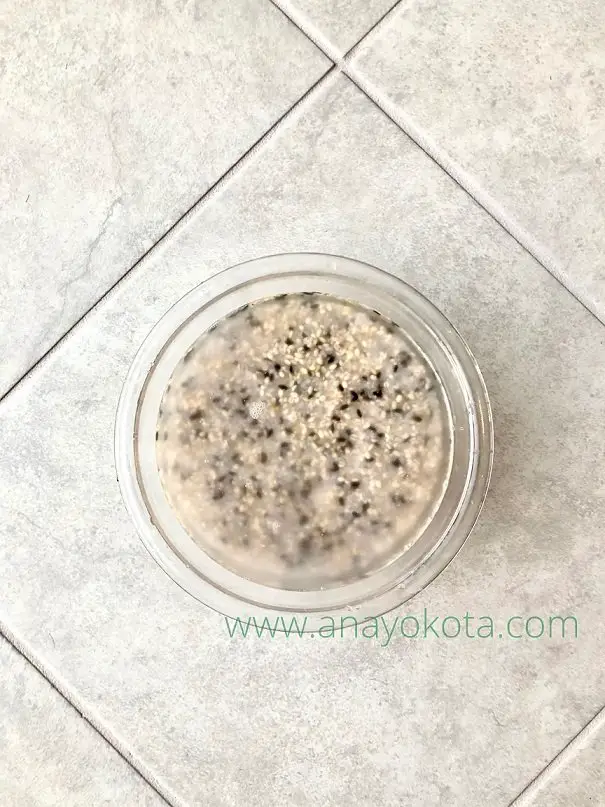
- Set the pressure cooker for regular rice. Make sure it is the REGULAR rice setting, which should be about 45-55 minutes for the average rice pressure cooker.
- Once the rice is done, fluff the rice using a rice paddle. Do not use any metal utensils as this may scratch the rice cooker bowl.
- Serve and enjoy!
- INSTRUCTIONS FOR INSTANT POT
- Follow rice cooker instructions 1-4.
- Set the Instant Pot Pressure Cook to High and set the steam release to Sealing.
- Set the timer for 3 minutes and allow a natural release for 10 minutes.
- Release the remaining pressure and fluff the rice using a rice paddle.
- Serve and enjoy!
- INSTRUCTIONS FOR STOVE TOP
- Follow rice cooker instructions 1-4. But instead of putting the rice in a pressure cooker, put it over a medium pot with a lid. You want the pot to be at least triple the size of the amount of rice to give the rice space to cook and water to boil.
- Bring the pot to a boil over medium high heat until the water begins to boil. Depending on the type of stove, this may take about 6-10 minutes.
- Once it comes to a boil, stir the rice so that it doesn’t stick to the bottom of the pan. Once you give it a good stir, reduce the heat to medium low or just low enough so that the water maintains a low simmer. Cover the pot with the lid.
- Let the rice simmer (DO NOT OPEN THE LID) for about 10 minutes.
- After 10 minutes, taste the rice quickly without opening the rice lid too long. (Just spoon out a quick taste and close the lid.)
- If the rice is ready to your desired texture (soft with a slight bite from the barley), you may remove the lid and fluff the rice with a rice paddle.
- Serve and enjoy!
Notes
- My favorite way to cook the Korean purple rice recipe is using a rice pressure cooker, then the stove top, then the instant pot.
What is your favorite rice ratio combination? Did you use other whole grains or add legumes/beans making Korean bean rice? If you would like to learn more about how to properly store rice, please let me know and I can add that to my next post!
If you are looking into inspiration on what to serve with your Korean purple rice, you may like trying Korean gamjatang (Korean pork bone soup). I hope you enjoyed learning about Korean purple rice and I hope you give this healthy version a try.




